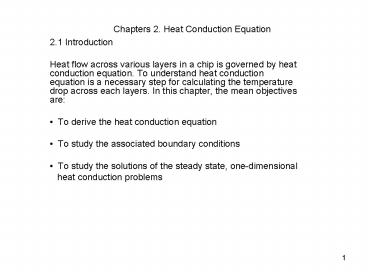Chapters 2' Heat Conduction Equation PowerPoint PPT Presentation
1 / 17
Title: Chapters 2' Heat Conduction Equation
1
Chapters 2. Heat Conduction Equation
- 2.1 Introduction
- Heat flow across various layers in a chip is
governed by heat conduction equation. To
understand heat conduction equation is a
necessary step for calculating the temperature
drop across each layers. In this chapter, the
mean objectives are - To derive the heat conduction equation
- To study the associated boundary conditions
- To study the solutions of the steady state,
one-dimensional - heat conduction problems
2
2-2 The general heat conduction equation
- (1) Heat conduction across an elemental volume,
T f(x,y,z,t) - is the rate of heat flow into the elemental
control volume dxdydz across the element surface
dydz at x. - The rate out flow of heat across the element
surface dydz at xdx is
x xdx
3
- The net rate of heat energy that flows into the
control volume from the x direction - Similarly, the net rates of heat energy that flow
into the control volume from the y and z
directions are, respectively, - The net rate of heat that flows into the control
volume from all directions
4
- (2) Internal heat generation in the
elemental volume - The rate of heat generation inside
in volume is - is the rate of energy
generation per unit volume (W/m3) - (3) Applying the principle of conservation
of energy for a closed system, - the net heat input to the elemental
volume is equal to the increase of - internal energy.
- The general heat conduction equation
is
5
2-3 Special forms of heat conduction equations
- Constant thermal conductivity, k constant
- No heat generation source within the system
- is called thermal diffusivity. It
indicates how fast the heat diffuses in the
medium. - Steady state heat conduction with internal heat
generation - Steady state and no internal heat generation in
the medium - It is a Laplace equation
6
2-3 One-dimensional heat conduction equations
- One-dimensional (There is no temperature gradient
in y z directions), unsteady, constant k with
internal heat generation. - One-dimensional, steady state, constant k with
internal heat generation. - One-dimensional, steady state, constant k and no
internal heat generation.
7
2-4 The general heat conduction in cylindrical
coordinates
- Cylindrical coordinates with
- constant k
- One-dimensional (there is no temperature gradient
in z and F directions), unsteady, constant k, and
with internal heat generation - One-dimensional, steady state, and constant
k with internal heat generation - One-dimensional, steady state, constant k,
and no internal heat generation.
8
2.4 Boundary conditions for steady state,
one-dimensional heat conductions
- Below is a plane wall with a thickness L. The
left hand surface is located at x - 0 and the right hand side is located at x L.
The temperature or heat flux - at any point on the wall may be specified as
boundary conditions. The - common boundary conditions for 1-dimensional,
steady state hea - conduction problems are
- Constant surface temperature If the
- temperature at x 0 is constant
- T T(0) constant
To - Constant surface heat flux if the heat flux
across the plane x 0 is constant.
9
- Adiabatic or insulated surface, there is no hat
flow across the plane x 0 - Convection boundary condition at x L, the
ambient fluid temperature is . The heat flow
rate from the internal point of the plate to the
surface x L is equal to the convection heat
transfer rate to the ambient air - Interface boundary condition
-
0 L
- Symmetric boundary condition
- There is no heat flow across the
symmetric plane.
10
Example 2-13 heat conduction in the base of an
iron
- Given P 1200W, L 0.5cm, A 300cm2, k
15W/mK, constant - 20oC h 80W/m2K
-
L
0.5cm - Find - Temperature distribution
x - - T(0) and T(0.5cm)
- Assumption the area is much larger than the
thickness. One-dimension application is possible,
steady state operation, and constant k - Solution
- - Governing equation and boundary
conditions
T8 h air
11
- - The solution integrating once
- Applying boundary condition 1
- Integrating again
- Applying boundary 2
- The temperature profile
- Temperature at x 0
- Temperature at x 0.005m
12
Ex. 2-18 Variation of temperature in a resistance
heater
- Given ro 5mm, k 100W/mK,
- g 5000W/m3, To 105oC
- Find (1) temperature distribution
- (2) maximum temperature
- Assumptions
- - steady state
- - very long one-dimensional
- - k constant
- - uniform internal heat generation
- The governing equation boundary conditions.
- - Heat conduction equation
- - the boundary conditions
- (1) constant surface T at r ro
- (2) symmetric Temperature
- distribution at the center
13
- - Integrating once
- - Applying second boundary condition
- - Rearranging the equation
- - Integrating again
- - Applying the first B. C.
- - The temperature distribution
- - The max. temperature occurs at x 0
14
- The following pages will not be taught
15
2.5 Solution of steady one-dimensional heat
conduction problem
- (3) Heat conduction in a long solid
circular cylinder with heat generation - Assumptions
- - One-dimensional and uniform internal
heat generation - - k constant
- - Convection heat transfer coefficient is
h and ambient fluid - temperature is T8.
- - Steady-state
- The 1-D heat conduction equation in cylindrical
coordinates - The boundary conditions
- The solution Integrating once and apply the
first boundary condition,
16
(No Transcript)
17
- Repeat integration and get The temperature
gradient at ro. - Applying the second boundary condition
- Temperature at ro
- The temperature profile is
- or
- The maximum temperature occurs at the center, r
0.

